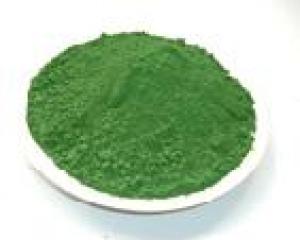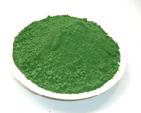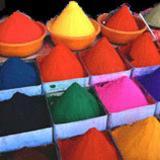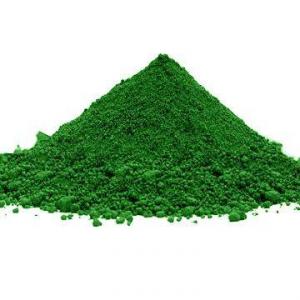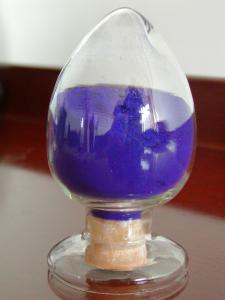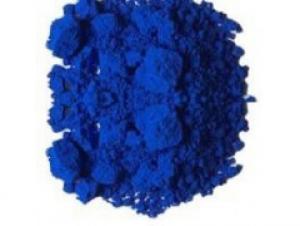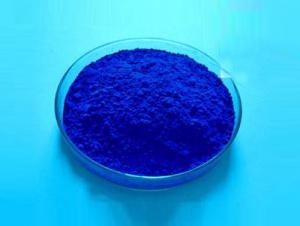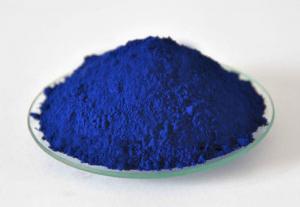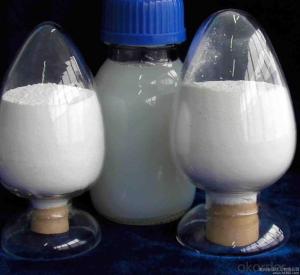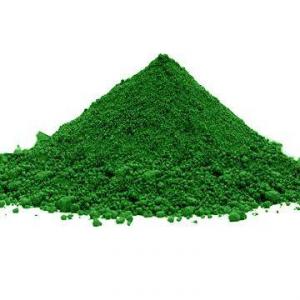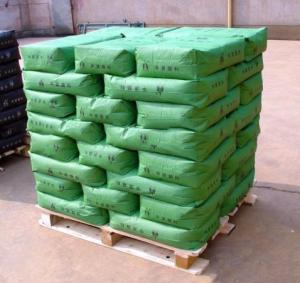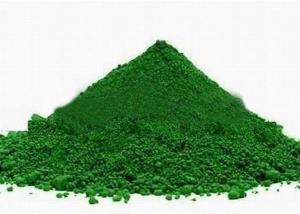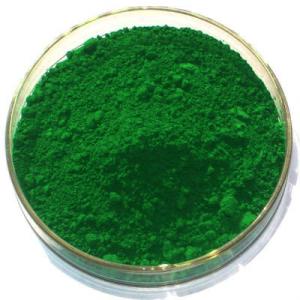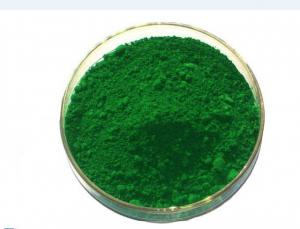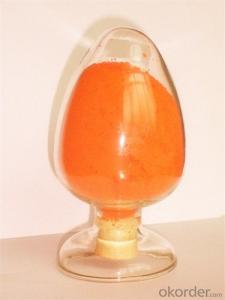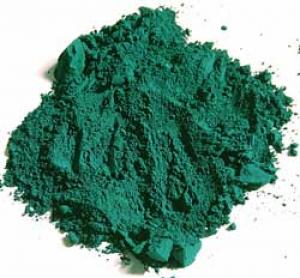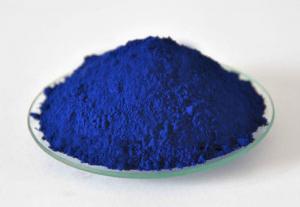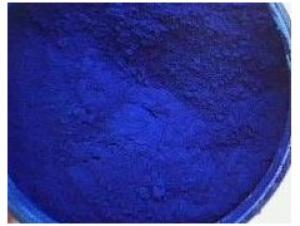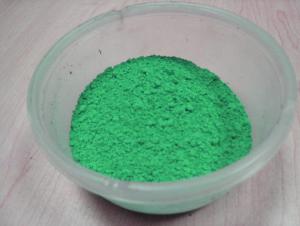Chrome Oxide Green For Pigment
- Loading Port:
- Tianjin Port
- Payment Terms:
- TT or LC
- Min Order Qty:
- 1 Metric Ton m.t.
- Supply Capability:
- 8000MT Per Year m.t./month
OKorder Service Pledge
OKorder Financial Service
You Might Also Like
Chrome Oxide Green For Pigment :
1. Product Name: Chrome Oxide Green
2. Molecular Formula: Cr2O3
3. HS Code: 2819900000
4. CAS No. : 1308-38-9
5. Appearance: green powder
8. Specifications: (Quality Standard: HG/T 2775-1996)
Packing Of Chrome Oxide Green For Pigment :
25 kg/bag , 20 MT / 20 FCL . Or as your requirements .
Usage Of Chrome Oxide Green :
Mainly used in paint, glass, ceramics, building materials colorants, printing ink, metal polishing,
smelting metal chromium, fire-proof material, etc.
Pigment Grade:
Item | Index | ||
Excellent Grade | First Grade | Qualified Grade | |
Appearance | Green Power | ||
Color Reference | Same | ||
Relative Color Strength | Strength | ||
Density g/cm3 | 4.8 | ||
Cr2O3 | ≥ 99.0% | ≥ 98.0% | ≥ 97.0% |
Cr+6 ppm | ≤ 5 | ||
Soluble Chrome | ≤ 0.03% | ≤ 0.03% | ≤ 0.03% |
105°C Volatile Matter | ≤ 0.3% | ≤ 0.3% | ≤ 0.3% |
Water Soluble | ≤ 0.1% | ≤ 0.4% | ≤ 0.7% |
Moisture | ≤ 0.15% | ≤ 0.3% | ≤ 0.5% |
PH of Water Solution | 7—7.5 | ||
Oil Absorption (g/ 100g) | 17 | ||
Residue on Sieve of 0.045 mm | ≤ 0.1% | ≤ 0.3% | ≤ 0.5% |
1200℃ Ingition Decerement | 0.05 | ||
Acid& Alkali Resistance | 5 | ||
Temperature Stability | 1000 | ||
Weather Fastness | 5 | ||
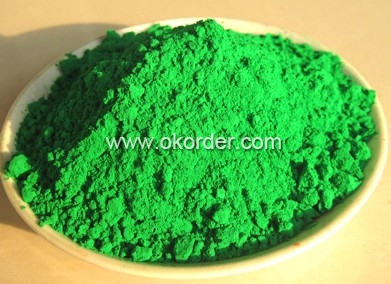

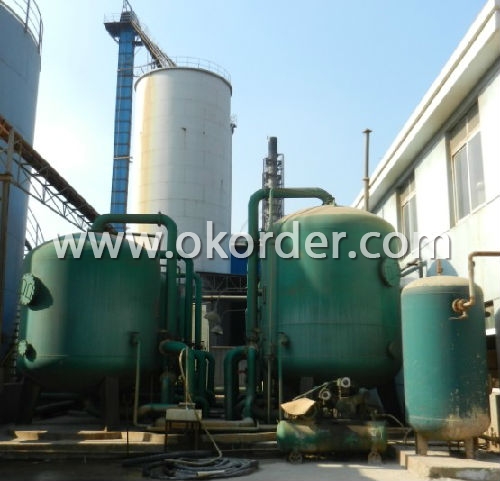
- Q: explain an absorption spectrum of different pigments and the action spectrum ofphotosynthesis.
- A pigment is any substance that absorbs light. The color of the pigment comes from the wavelengths of light reflected (in other words, those not absorbed). Chlorophyll, the green pigment common to all photosynthetic cells, absorbs all wavelengths of visible light except green, which it reflects to be detected by our eyes. Black pigments absorb all of the wavelengths that strike them. White pigments/lighter colors reflect all or almost all of the energy striking them. Pigments have their own characteristic absorption spectra. The action spectrum of photosynthesis is the relative effectiveness of different wavelengths of light at generating electrons. If a pigment absorbs light energy, one of three things will occur. Energy is dissipated as heat. The energy may be emitted immediately as a longer wavelength, a phenomenon known as fluorescence. Energy may trigger a chemical reaction, as in photosynthesis. Chlorophyll only triggers a chemical reaction when it is associated with proteins embedded in a membrane (as in a chloroplast) www.emc.maricopa.edu/faculty/fara...
- Q: pretty self-explanatory...
- Pigments help in making food for the plants they also give color to it.Pigments are of different types which give different color to its leaves or fruits.Like mango is green first and then turns yellow coz green pigment is replaced by yellow pigment. Green pigment in most of the fruits is present only till it requires food and is raw.
- Q: Explain why plants need a variety of pigments to carry out photosynthesis?
- It is particularly obvious in seaweeds. The pigment employed by the plant will vary according to the light available, so that seaweeds in shallow water tend to be green but those from deeper water are brown and then, where light levels are really low, seaweeds are red. In most of these cases photosynthesis is still carried out by chlorophyll but the associated pigments help with the absorption of the available light.
- Q: What is a pigment and their function in photosynthesis?
- a pigment is any substance that absorbs light. chlorophyll, the green pigment common to all photosynthetic cells, absorbs all wavelengths of visible light except green, which it reflects to be detected by our eyes. black pigments absorb all of the wavelengths that strike them. white pigments/lighter colors reflect all or almost all of the energy striking them. pigments have their own characteristic absorption spectra, the absorption pattern of a given pigment. a photosynthetic pigment or chloroplast pigment is a pigment that is present in chloroplasts or photosynthetic bacteria. its function is to capture the light energy necessary for photosynthesis. :)
- Q: How many pigments does grass reflect?
- Pigments are the colors that make grass look green. They are the pigments that do photosynthesis. Grass looks green because it reflects green light. It reflects the wavelengths of light that have the frequency of green light. Grass has other pigments that we do not see through the chlorophyll, but it is the light that is reflected.
- Q: i was thinking of this all day long and then i thought of posting this question for you to help me sort it out
- Pigments are molecules that absorb specific wavelengths (energies) of light and reflect all others. Pigments are colored: the color we see is the net effect of all the light reflecting back at us. Absorb: Electrons in molecules can exist at specific energy levels. Normally they exist at the lowest possible energy level they can. However, if enough energy comes along to boost them into the next level, they can absorb that energy and occupy that higher level. This is what pigments do. The light they absorb contains' just the right amount' of energy necessary to push them into the next level. Any light that does not have enough or has too much energy can not be absorbed and is reflected. The electron in the higher energy level, however, does not 'want' to stay there(i.e. it is unstable). It 'wants' to return to its normal lower energy level. In order to do this it must get rid or release the energy that has put it into the higher energy state to begin with. This can happen several different ways: 1) The extra energy can be converted into molecular motion and lost as heat. 2) Some of the extra energy can be lost as heat energy, while the rest is lost as light. This re-emission of light energy is called florescence. 3)The energy, but not the e- itself, can be passed onto another molecule. This is called resonance. 4)The energy and the e- can be transferred to another molecule. Plant pigments usually utilize the last two of these reactions to convert the sun's energy into their own. When chlorophyll is isolated from the enzymes it is associated with, the second scenario can be seen to happen.
- Q: Can someone describe the role of accessory pigments in photosynthesis?
- Accessory Pigments In Plants
- Q: (After the fifteenth century)
- Pigment is color in powder form. An example is lamp black; it was first made from the soot of kerosene lamps ground fine. Binder is a substance used to hold pigment together and make it adhere; in the previous example, linseed oil would be the binder for the lamp black pigment. Vehicle is a medium acting as a solvent, carrier, or binder for paint; turpentine or mineral spirits would be a vehicle but so would linseed oil as well to help dilute the paint and help it cover a large area. Hope that helps and thanx.
- Q: light absorption, which pigments are involved?
- All photosynthetic organisms contain one or more organic pigments capable of absorbing visible radiation, which will initiate the photochemical reactions of photosynthesis. The three major classes of pigments found in plants and algae are the chlorophylls, the carotenoids and the phycobilins. Carotenoids and phycobilins are called accessory pigments since the quanta (packets of light) absorbed by these pigments can be transferred to chlorophyll. Chlorophylls chlorophyll a - present in all higher plants and algae chlorophyll b - present in all higher plants and green algae chlorophyll c - diatoms and brown algae chlorophyll d - red algae (chlorophyll a is present in all photosynthetic organisms that evolve O2.) Chlorophyll molecules contain a porphyrin 'head' and a phytol 'tail'. The polar (water-soluble) head is made up of a tetrapyrrole ring and a magnesium ion complexed with the nitrogen atoms of the ring. The phytol tail extends into the lipid layer of the thylakoid membrane. Carotenoids (carotenes and xanthophylls) Carotenes: -carotene - higher plants and most algae $-carotene - most plants some algae xanthophylls: luteol, fucoxanthol and violaxanthol Carotenoids contain a conjugated double bond system of the polyene type (C-C=C-C=C). Energy absorbed by carotenoids may be transferred to chlorophyll a for photosynthesis. Phycobilins (found mostly in red and blur-green algae): phycoerythrin phycocyanin allophycocyanin )
- Q: So i'm writing up a lab report and i'm just a little confused on why scarlet, rosy, cinnabar and vermillion mutants contain the same kinds and amounts of pigments found in wild-type according to paper chromatography. Since they're mutants shouldn't it be different? I don't understand how i'm going to explain that they are mutants when it appears that they have the same phenotype as wild-type. Thank you so much for your help!
- Man pigments determine the colour of the eye. If the composition of pigments is same in all the flies,how can the colour in which their eyes look differ?isn't this a contradiction?i suspect the accuracy of The chromatography test because even a very very slight change in the amount of pigment can significantly change the colour. The phenotype is always different in mutants due to different genotype. in genotype is taken for granted if a change in phenotype is present. Wait just got over into a nice point. Sometimes even if the pigment composition being same different colours m8 be produced due to different allotropes or iro of the same pigment might have different colours!though allotropes(not isomers) have same composition but differ in,their post translational changes r different.since post translational changes r indirectly influenced by genes.this completely explains this case.
1. Manufacturer Overview
| Location | Liaoning, China |
| Year Established | 1960 |
| Annual Output Value | Above US$ 100 Million |
| Main Markets | 20.00% North America 20.00% South Asia 10.00% Middle East 10.00% North America 10.00% Northern Europe 10.00% South Asia 10.00% Western Europe 5.00% Africa 5.00% Eastern Europe |
| Company Certifications | ISO9001:2000 |
2. Manufacturer Certificates
| a) Certification Name | |
| Range | |
| Reference | |
| Validity Period |
3. Manufacturer Capability
| a) Trade Capacity | |
| Nearest Port | Dalian Port |
| Export Percentage | 41% - 50% |
| No.of Employees in Trade Department | 10-20 People |
| Language Spoken: | English; Chinese; |
| b) Factory Information | |
| Factory Size: | Above 10,000 square meters |
| No. of Production Lines | Above 6 |
| Contract Manufacturing | design and manufacture service offered. |
| Product Price Range | High; Average |
Send your message to us
Chrome Oxide Green For Pigment
- Loading Port:
- Tianjin Port
- Payment Terms:
- TT or LC
- Min Order Qty:
- 1 Metric Ton m.t.
- Supply Capability:
- 8000MT Per Year m.t./month
OKorder Service Pledge
OKorder Financial Service
Similar products
Hot products
Hot Searches
Related keywords


